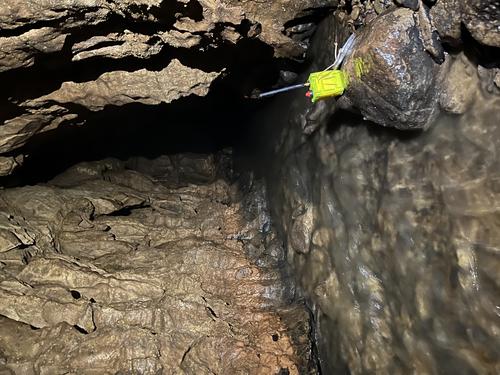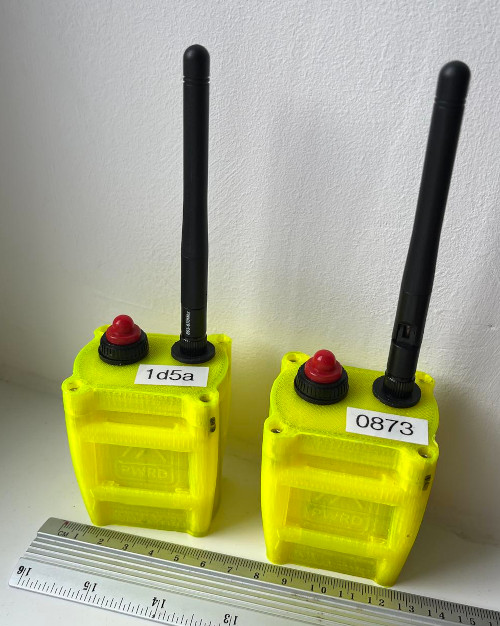README.md
Long range, low power messaging system based on Meshtastic relays suitable for underground communications.
Design principles
Natural caves are challenging as it comes to communications due to irregular cavity shapes, presence of water and general difficulty of installing any kind of equipment in an environment where everything has to be carried on human's back over hundreds of meters vertically. There are numerous existing solutions, each with its own challenges:
- Wired telephone is a reliable solution, however poses a significant investment due to the above challenges, plus it is easily damaged in confined or gravel passages.
- Through-the-earth radio communications using very low radio frequencies (HeyPhone, Nikola, CaveLink) are the most popular ad-hoc communications solution during cave rescue or expeditions . Obtaining a reliable link at depths below hundreds of meters however is a lottery as many factors from geology to weather impact attenuation even at low frequencies.
- Underground communication links based on radio repeaters was discussed at least since 20141. Sybet came up with industrial solution SPELLCOM using radio repeaters to relay voice communications over underground cavities.
The Vangelis project expands on all of the above by using autonomous low-power repeaters for relaying text messages rather than voice over low-power radio transmission:
- Radio transmission using LoRA modulation using Meshtastic protocol for routing
- Low-power radio transmission with maximum 200 m line-of-sight range for underground nodes
- Long-term autonomous operations of each relay node
- Low weight and portability of the nodes
- Range of surface relays limited only by LoRa radio reach, practically up to a few kilometers in mountainous areas
- Consumer smartphones connecting over Bluetooth to relay nodes using Meshtastic app to send and receive messages
Hardware
The system is composed of two node types: surface and underground. Each node operates in router-client mode, which allows both client device (smartphone) connection over Bluetooth and message relaying to other nodes over LoRa.
- surface node
- cave node powered from a LiPo battery and intended to operate without recharging for the whole period of a cave operation
Surface node
Relay node intended to be used outdoors and thus not subject to size and weight limitations. The prototype is powered from a 18650 cell with PV charging, equipped with a 3-5 dBi antenna. Typical usage scenario is to be installed at cave entrance and relay messages further to another such node at a base camp. The node can be equipped with a GPS receiver.
Bill of materials:
- Clear Hinged Lid IP67 Waterproof ABS Electrical Enclosure Case junction box
- WisBlock Meshtastic Starter Kit
- OLED Display Solomon SSD1306 - RAK1921
- RAKBox-B5 Transparent Acrylic Enclosure
- Outdoor LoRA antenna any antenna can be used, two prototype nodes were built with 3 dBi and 5 dBi antennas
- 3D-printed antenna holder, STL for RAK 3dBi Fiberglass Antenna or 5dBi Fiberglass Antenna are available
- 5V 1.25W 250 mA photovoltaic panel, 110mm x 69mm, 2.4mm
Notes:
- OLED display is optional. It's mostly useful when pairing smartphone with Meshtastic over Bluetooth using a random PIN code, but since these are impractical underground, the nodes are configured to use no PIN at all. Since it also displays last packet information etc it's a nice to have.
- Choice of the antenna is of paramount importance for outdoor LoRA range. Poor antenna will limit the range to tens or hundreds of meters at best, even in line of sight. With RAK 3-5 dBi antennas we easily get kilometers long range. It does not matter for underground nodes as their range is limited by rock anyway.
Cave node
Durable, waterproof case made of 3D-printed plastic, indented to be operated in hostile environment and simplified operations. Prototype weight ~130 grams. The only user interface is the power button on the top, that is big enough to be operated in gloves. The WisBlock board has a green, blinking LED which is visible through the plastic case and serves as an indicator that the device is live and transmitting. The case has an USB-C port on the bottom that in normal conditions is closed with a rubber seal.
Bill of materials:
- RAK WisBlock Mini Base Board RAK19003
- RAK LoRa Core Module RAK4631
- RAK barometric pressure sensor RAK1902
- LoRa 2 dBi SubG antenna
- IPEX to RP-SMA connector
- BLE-PCB Bluetooth antenna
- TacMesh Waterproof Enclosure 3D printed from PLA, assembly instructions
- Waterproof on-off switch
- 3.7V 2000 mAh LiPo battery
- Rubber washer 16x6x1.5 mm
- Rubber O-ring 49x45x2 mm
- Tactile 4x4x1.5 mm push button not installed in the cave prototypes, mostly needed for node reset for firmware upgrade
- USB-C male to female coupler
- Rubber USB-C plugs
Future improvements
Barometric pressure
As cave nodes are located through the cave, they have no means of determining their own location as GPS signal is unavailable. Barometric pressure sensor allows to correlate the pressure seen by a node with altitude above mean sea level (AMSL) as long as at least one surface node is equipped with GPS receiver and barometric pressure sensor. The surface node would then operate as the barometric reference for the whole network. With this improvement, the Meshtastic application would see the nodes identified by their depth rather than merely names, e.g.:
- 0 m relative (surface node)
- -50 m
- -100 m
- -200 m etc
Messages sent to the channels could be also identified by the depth of the respective relay node, thus indicating that team X has reached -100 m, then -200 m etc.
Cable communications
Long, tight crawls are especially challenging for connecting using relay nodes due to relatively short (~10 m max in our tests) radio range and high risk of the nodes being displaced or damaged by cavers moving with bags in confined space. In theory, the nodes could be also connected using a serial cable connected to the USB-C port, which could replace the radio link through the problematic tunnel. The Meshtastic firmware currently supports serial communications but not exactly for node-to-node links. The length of such a hypothetical link and how it would need to be powered is also unknown.
Footnotes
-
M. D. Bedford; G. A. Kennedy Modeling Microwave Propagation in Natural Caves Passages, IEEE Transactions on Antennas and Propagation, 2014 ↩︎




